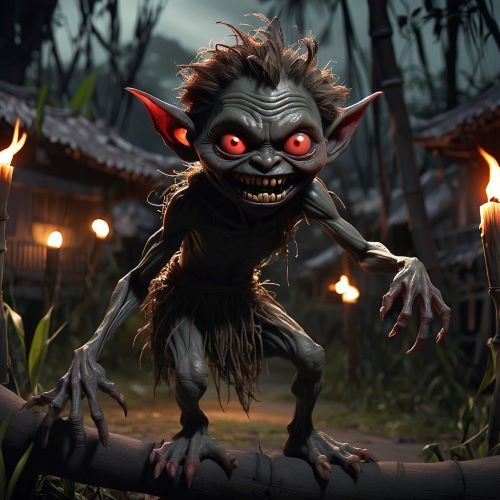Multo : The Wandering Ghost
Listen
At a glance
| Description | |
|---|---|
| Origin | Philippine Mythology |
| Classification | Ghosts |
| Family Members | N/A |
| Region | Philippines |
| Associated With | Haunting, Possession |
Multo
Introduction
In Philippine mythology, the term *Multo* refers to the spirit or ghost of a deceased being—be it a person or an animal—that makes its presence felt in the world of the living. This spectral figure holds an important place in Filipino folklore, embodying beliefs surrounding life after death and a deep respect for ancestors. The idea of *Multo* sparks a blend of wonder and fear, drawing people into the mysteries of the afterlife and the supernatural, which are woven into the cultural heritage of the Philippines.
*Multo* holds a special significance in Filipino tales and traditions, often appearing in eerie stories that carry moral undertones, cautioning individuals to honor the dead and keep connections with their ancestors alive. This belief system acknowledges both benevolent and malevolent spirits, illustrating the complexity of Filipino views on the afterlife. The concept of *Multo* ranges from kind-hearted spirits of loved ones to ominous entities that provoke unease, making it essential to understanding the intricate nature of Philippine folklore and its supernatural landscape.
Physical Traits
The appearance of Multo varies widely across Philippine folklore, with each description lending a unique sense of mystery to these spirits. Often, they are said to manifest as shadowy or partially transparent figures, capturing the image of the deceased just as they were in life, though slightly faded or ghostly.
In some stories, Multo take on a human-like appearance with striking realism, occasionally dressed in traditional attire or the final clothing worn before their passing, adding a personal touch that resonates with the living. Other accounts describe them as wispy, indistinct shapes, emphasizing their otherworldly, intangible essence.
Multo can also present in ways intended to inspire fear or convey a message, showing themselves as eerie, unsettling apparitions. These forms can serve as warnings or express unresolved emotions, adding to their enigmatic role in folklore. While Multo are never bound to one form, each appearance is steeped in symbolism, reflecting the diversity and depth of beliefs about spirits in Philippine culture.
Family
In Philippine mythology, Multo is part of a vast supernatural realm, closely woven with other mystical beings that shape Filipino folklore and cultural beliefs. Unlike entities tied to a lineage or deity, Multo usually represent souls unable to find peace, often due to sudden or traumatic deaths, unresolved matters, or lingering emotional bonds.
The tales of Multo often intersect with those of other mythical beings. For instance, Aswang—sinister, shape-shifting creatures associated with death and misfortune—are sometimes seen in stories alongside Multo, intensifying the haunting atmosphere. Similarly, Engkanto, the charming nature spirits, can be found in legends where Multo appear after humans disturb the natural order, blending the mysteries of the supernatural with consequences for disrespecting nature.
Meanwhile, Diwata, who are like guardians or deities of nature, embody the importance of reverence for mystical forces. They sometimes share the stage with Multo in folklore that underscores respect for the unseen world. Rather than being linked by family, Multo are spirits bound by circumstance, representing a liminal state between the world of the living and the peace of the afterlife.
Other names
In the Philippines, the term Multo broadly encompasses ghosts or spirits, but its interpretation can vary across different regions and narratives. In some areas, these entities might be called “bangungot,” a term linked to spirits associated with nightmares. Another common term is “alma en pena,” which describes wandering souls that are restless and unable to find peace. While Multo is often translated as “ghost” in English, it reflects a rich cultural tapestry with various local names that highlight the Philippines’ diverse traditions.
For instance, the term “patay,” which means “dead,” is sometimes used interchangeably with Multo, particularly in regions influenced by Spanish colonization. In certain contexts, Multo may also overlap with Engkanto, especially when the spirit takes on enchanting characteristics. Similarly, while Diwata generally refers to benevolent nature spirits, in some places, it can denote Multo when the spirit acts as a protective ancestor or guardian. Lastly, the term “mumu” is used in a more casual or humorous way in specific locales to refer to ghosts or spirits, often carrying a light-hearted connotation.
Powers and Abilities
Multo is associated with a range of powers that reflect the cultural beliefs surrounding death and the afterlife. One of the most notable abilities is their manifestation, which serves as a significant sign to the living. When a Multo appears, it may signal unfinished business or unresolved issues from their life, prompting reflection among those who encounter them. Additionally, they can communicate with the living, often through dreams or physical appearances, delivering important messages or warnings that may help guide individuals away from danger or inform them about family matters.
The presence of a Multo can also serve as a cautionary symbol, often heralding misfortune and encouraging people to reconsider their actions, particularly regarding their treatment of family and ancestors. While they typically present as spirits, some accounts suggest that Multo can shapeshift, taking on characteristics of other mythical beings, depending on the local lore.
Beyond these general abilities, Multo may exhibit specific supernatural powers. For instance, they can haunt particular locations, especially those tied to their past or significant life events. In certain tales, Multo may possess living individuals, leading them to behave in unexpected ways. Some are even said to possess telekinetic abilities, allowing them to move objects or create disturbances without any physical interaction. Lastly, the mere presence of a Multo can instill feelings of fear or unease, leaving a lingering sense of dread among those who encounter them.
Modern Day Influence
The concept of Multo is deeply embedded in contemporary Filipino culture, appearing across various forms of literature, art, and performance. In literature, stories featuring Multo often explore themes of family, heritage, and the implications of unresolved death, urging readers to confront their histories. Works like “Mga Multo” delve into the complexities of familial bonds and the haunting presence of the past. Similarly, in the visual arts, representations of Multo frequently depict ghostly figures intertwined with nature or traditional contexts, symbolizing the delicate balance between life and death.
In theater and performance, productions such as “Multo: A Performance on the Representation of Undocumented” draw connections between the ghosts of the past and the struggles faced by marginalized communities today. This theme of the past’s specters haunting the present is also prevalent in media, where horror films and television series often feature Multo-inspired narratives, captivating audiences with tales of ancestral spirits and haunted locations. Additionally, the belief in Multo plays a significant role in traditional rituals aimed at appeasing or banishing spirits, ensuring that these stories continue to be passed down through generations and preserving the rich tradition of Philippine folklore.
Related Images
Source
“10 Philippine Mythical Creatures Travelers Should Look Out For.” Traveloka, October 30, 2017.
“Philippine Mythical Creatures Facts & Worksheets – KidsKonnect.” February 10, 2021.
Various authors. “Mga Multo urges us to take a look into the ghosts in our lives.” Medium, July 22, 2024.
Ablir, Ralph. “Multo: The Wandering Souls of Philippine Folklore.” Pinoymyths, 10 May 2024. https://pinoymyths.com/multo-the-wandering-souls-of-philippine-folklore/
“List of Philippine mythological creatures.” Wikipedia, 2024. https://en.wikipedia.org/wiki/List_of_Philippine_mythological_creatures
“Top 10 Scariest Mythological Creatures in the Philippines.” Spot.ph, 23 Oct 2014. https://www.spot.ph/arts-culture/57490/top-10-pinoy-mythological-creatures
“Philippine Mythology.” Mythology.net, 2024. https://mythology.net/philippine-mythology
“Philippine Folklore and Mythology.” Philippine Folklore Society, 2024. https://philippinefolkloresociety.org/
Frequently Asked Questions
What is lorem Ipsum?
I am text block. Click edit button to change this text. Lorem ipsum dolor sit amet, consectetur adipiscing elit. Ut elit tellus, luctus nec ullamcorper mattis, pulvinar dapibus leo.
What is lorem Ipsum?
I am text block. Click edit button to change this text. Lorem ipsum dolor sit amet, consectetur adipiscing elit. Ut elit tellus, luctus nec ullamcorper mattis, pulvinar dapibus leo.
What is lorem Ipsum?
I am text block. Click edit button to change this text. Lorem ipsum dolor sit amet, consectetur adipiscing elit. Ut elit tellus, luctus nec ullamcorper mattis, pulvinar dapibus leo.
What is lorem Ipsum?
I am text block. Click edit button to change this text. Lorem ipsum dolor sit amet, consectetur adipiscing elit. Ut elit tellus, luctus nec ullamcorper mattis, pulvinar dapibus leo.
What is lorem Ipsum?
I am text block. Click edit button to change this text. Lorem ipsum dolor sit amet, consectetur adipiscing elit. Ut elit tellus, luctus nec ullamcorper mattis, pulvinar dapibus leo.













